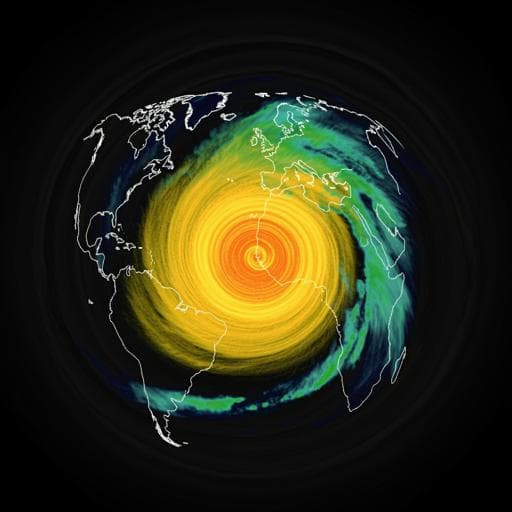
Earth Sciences
Increase in insurance losses caused by North Atlantic hurricanes in a warmer climate
F. Comola, B. Märtl, et al.
Discover the startling findings of research conducted by Francesco Comola, Bernhard Märtl, Hilary Paul, Christian Bruns, and Klaus Sapelza, which projects significant increases in insurance losses from North Atlantic hurricanes due to climate change. Learn how warming scenarios could reshape the landscape of hurricane-related financial risks, with expected losses potentially escalating by up to 30%.
~3 min • Beginner • English
Introduction
North Atlantic hurricanes are among the most damaging natural hazards in the United States, historically driving a large share of global insured property losses. Climate variability and warming can alter key ingredients for hurricanes (moisture, ocean warmth, wind shear), with medium-to-high confidence for increases in hurricane wind intensity and rainfall rates and likely higher storm surges. Projections for a +2 °C warming suggest fewer total storms but a higher fraction reaching major intensity and higher precipitation, though uncertainties are substantial. Prior work has related wind, precipitation, and surge to economic losses and suggested sizable increases in average annual losses (AAL), yet the combined, insurance-focused impact of wind, precipitation, and storm surge remains unclear. This study asks: How will projected changes in hurricane intensity and precipitation under +2 °C and +4 °C warming affect U.S. property insurance losses? The purpose is to isolate climate-driven changes (separate from exposure growth, economic and social inflation) and quantify impacts across the loss distribution and by hazard component, informing insurers and policymakers about risk evolution and adaptation needs.
Literature Review
The paper synthesizes multiple strands of literature: climate change effects on tropical cyclone intensity and rainfall (e.g., Knutson et al. 2010, 2020; Walsh et al. 2016, 2019) indicate likely stronger winds and higher rain rates with warming, and potential for higher storm surge. Projections compiled for +2 °C warming show median decreases in overall hurricane frequency, increases in the fraction of major hurricanes (Cat 4–5), and increases in hurricane-induced precipitation, albeit with high uncertainty and model spread. Economic loss studies have linked hurricane wind speeds to insured losses and examined freshwater flood and storm surge contributions to risk, including potential future increases in losses due to intensified precipitation and storm characteristics. Some studies project notable AAL increases (e.g., ~14% at +2 °C) and up to ~30% increases in freshwater losses under high-emissions scenarios by century’s end in some regions. However, uncertainty in future frequency, size, track, and speed, and the combined insurance impact of multiple hazards have remained open questions, motivating the present integrated, insurance-loss-focused analysis.
Methodology
Data and integration: The study compiles nearly 150 loss-causing North Atlantic storms (1950–2022) by integrating three datasets: (1) HURDAT2 (NOAA) for storm tracks and maximum lifetime intensity (mapped to categories 0–5); (2) Property Claim Services (PCS) for insured wind-related property losses at state level since 1950; (3) NFIP claims (OpenFEMA) for flood losses since 1979, reclassified into precipitation (rain/river/lake overflow), storm surge (tidal overflow), and other. Losses are indexed to 2022 using a combination of the US GDP deflator and US property insurance gross premiums, yielding an average indexation factor of ~7% per annum. This produces a historical baseline AAL (~USD 21.7–21.8 billion) consistent with recent estimates. The methodology does not account for spatial development or vulnerability changes (e.g., defenses, building codes). Future hurricane climatology projections: For +2 °C, the authors adopt distributions of projected changes in hurricane properties compiled from multiple studies; for +4 °C, they extrapolate via exponential scaling with global mean surface temperature. Median projections: increased fraction of major hurricanes (+9% at +2 °C; +19% at +4 °C), uncertain frequency changes (median −14% and −27% at +2 °C and +4 °C, respectively; main analysis assumes no change in frequency), and increased hurricane-induced rainfall (+16% and +34%). Flood loss scaling relates increased rainfall to increases in number of affected policies (~0.85% per 1% flood depth increase) and average claim amount (~0.15% per 1% depth increase), implying median flood loss increases of ~16% (+2 °C) and ~35% (+4 °C). Storm surge impacts are implicitly captured through the higher share of major hurricanes; sea-level rise is excluded. Stochastic bootstrapping framework: A frequency–severity approach generates 10,000 simulated years for each climate scenario. Annual event counts are sampled from the empirical historical frequency CDF. Each year’s storms are split into hurricanes (Cat 0–3) and major hurricanes (Cat 4–5) using scenario-specific probabilities for major hurricanes (historical 40%, adjusted to 44% at +2 °C and 48% at +4 °C). Loss components (wind, precipitation, storm surge) are sampled jointly using a Gaussian copula to preserve observed cross-hazard dependence. Steps: (a) transform historical loss components to standard normal via quantile mapping; (b) estimate the 3×3 covariance matrix of transformed variables; (c) sample multivariate normal vectors via Cholesky decomposition; (d) back-transform to obtain loss triplets for hurricanes and major hurricanes using empirical CDFs for each hazard and intensity class. For exceedance levels beyond 72 years of history, the empirical CDFs are augmented using Verisk’s 10,000-year North Atlantic hurricane model (Touchstone Re v11.5) to extend tails. For future scenarios, precipitation losses are inflated by sampled projection factors; the fraction of major hurricanes is adjusted per projections. Uncertainty propagation: To capture projection uncertainty, 100 stochastic event sets are generated per scenario by sampling from the distributions of projected changes (major-hurricane fraction, precipitation increase, etc.). From these, median losses and inter-quantile ranges (50% and 80%) are derived for occurrence and aggregate annual losses across return periods. Baseline validation: Historical loss exceedance curves are compared with observed catastrophic events to infer baseline return periods and natural variability (via subdividing the 10,000-year set into 100 subsets to estimate inter-quantile ranges). Sensitivity: A supplementary analysis allows projected changes in overall hurricane frequency (with low scientific confidence) to assess the impact relative to the main assumption of unchanged frequency.
Key Findings
- Relative to 1950–2022, median projected changes in hurricane climatology increase occurrence losses by about 5–15% in a +2 °C scenario and 10–30% in a +4 °C scenario, with greater impacts at higher frequencies (lower return periods) than in the tail.
- The historical 100-year occurrence loss (~USD 220 billion) would have return periods of ~80 years (+2 °C) and ~70 years (+4 °C). The historical 50-year occurrence loss (~USD 150 billion) would shift to ~45 years (+2 °C) and ~40 years (+4 °C).
- Average annual loss (AAL) increases from USD 21.8 billion (historical) to USD 23.9 billion (+10%) at +2 °C and USD 25.3 billion (+15%) at +4 °C.
- Hazard breakdown of AAL (historical → +2 °C → +4 °C): wind: USD 19.5 → 21.1 (+8%) → 22.1 (+13%) billion; freshwater (precipitation-driven): USD 1.4 → 1.8 (+26%) → 2.2 (+55%) billion; storm surge: USD 0.96 → 1.03 (+8%) billion (value for +4 °C not specified in-text).
- Major hurricanes (Cat 4–5) account for a much larger fraction of aggregate annual losses in future climates. Their contribution to the 2-year return period annual loss rises from ~10% (historical) to ~50–60% in +2 °C and +4 °C scenarios.
- By AAL component, wind contributes the largest absolute increase; precipitation contributes the largest relative increase.
- Baseline exceedance: an event loss of ~USD 150 billion (e.g., Katrina/Andrew indexed to 2022) corresponds to ~50-year return period; ~USD 50 billion (e.g., Ian/Sandy/Hugo) to ~10 years. Annual aggregate: ~USD 200 billion (2005 season) has ~70-year return period; ~USD 150 billion (1992 season) ~40 years.
- Uncertainty (80% inter-quantile ranges): 100-year occurrence loss: USD 180–250 billion (+2 °C) and USD 160–290 billion (+4 °C); 50-year occurrence loss: USD 110–180 billion (+2 °C) and USD 100–210 billion (+4 °C). AAL: USD 16–27 billion (+2 °C) and USD 14–35 billion (+4 °C).
- Under SSP5-8.5 timing to +2 °C and +4 °C, the implied climate-driven AAL increase is ~0.5% per annum, with 90% probability of not exceeding ~0.8% per annum, smaller than typical man-made drivers (inflation, social inflation, exposure growth).
Discussion
The findings demonstrate that, even when isolating climate effects from exposure growth and inflation, warming-induced intensification and wetter storms are likely to elevate insured hurricane losses in the U.S. The shift toward a higher proportion of major hurricanes, combined with higher precipitation rates, disproportionately increases precipitation-related losses and raises the share of Cat 4–5 storms in annual aggregates, particularly at shorter return periods. While wind drives the largest absolute increase in AAL, precipitation sees the largest relative growth, consistent with expectations that heavier rainfall boosts both the number of policies affected and average claim size. Results are robust when substituting the historical dataset with a vendor stochastic event set, supporting the methodology. Nonetheless, projections are sensitive to uncertain aspects of hurricane climatology, especially overall frequency changes; when decreases in frequency are included (supplementary analysis), median losses may decline. Additional uncertainties stem from unmodeled factors like storm size, forward speed, and track shifts, and from complex hydrologic responses linking rainfall to insured flood claims. Sea-level rise is excluded, though it may independently increase coastal flood hazard more strongly than storm-induced precipitation and surge changes alone. In context, the projected climate-driven AAL increase (~0.5% per year over decades) is modest relative to other insurance loss drivers, implying that while climate change elevates hurricane risk, portfolio management must also account for inflationary and exposure trends. The results provide actionable guidance for insurers on evolving wind and flood risk, highlighting the need for adaptation strategies, pricing, and capital planning, especially in regions prone to heavy rain and surge.
Conclusion
Global warming, independent of changes in the building stock, is likely to increase U.S. property insurance losses from North Atlantic hurricanes. Stochastic modeling that integrates wind, precipitation, and storm surge losses, calibrated to historical data and informed by climate projections, indicates 5–15% (+2 °C) and 10–30% (+4 °C) increases in occurrence losses and a 10–15% rise in AAL, with precipitation driving the largest relative gains. The study offers quantitative benchmarks for insurers and policymakers to assess adaptation and mitigation needs in hurricane-prone regions and underscores the importance of managing exposure concentrations along the East and Gulf coasts. Future research should refine projections of hurricane frequency, storm size, speed, and track, improve rainfall-to-claims relationships, and incorporate sea-level rise and compound flooding to capture the full spectrum of future coastal risk.
Limitations
- Uncertainty in projected changes in hurricane climatology (especially overall frequency) leads to wide ranges in future loss estimates.
- Storm properties not explicitly modeled (size, forward speed, track shifts) could materially affect losses.
- Precipitation-to-claims relationships involve hydrologic and behavioral complexities; freshwater loss projections are preliminary.
- Sea-level rise is excluded, though it may significantly increase coastal flood hazard and interact with surge.
- Indexation does not capture spatial development patterns or changes in vulnerability (e.g., building codes, defenses).
- Use of maximum lifetime intensity as a proxy for future major-hurricane proportion assumes landfalling storms follow the same shift, regardless of landfall intensity.
Related Publications
Explore these studies to deepen your understanding of the subject.







